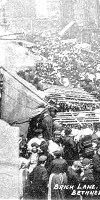|
The borough of Tower Hamlets gets its name from
the Tower of London, built during the reign of William the Conqueror
in the 11th century, and the small communities or hamlets that developed
on the surrounding marshland.
The wet marshland was eventually drained over the
years, allowing the people to build houses, which enabled communities
and trade in the area to grow. By the 16th century, Tower Hamlets
was an important location for many industries including metalworking
and brick making, which were considered too noisy and dangerous
to take place within the city boundaries.
New arrivals to a country often seem to settle within
a few miles of their arrival point, and this pattern led many to
form communities in the Tower Hamlets area, close to where their
ship docked on the River Thames. The borough has a long history
of welcoming people seeking refuge from persecution.
The mosque on the corner of Brick Lane and Fournier
Street has an interesting and varied past and is a perfect example
of the rich cultural history of Tower Hamlets as a whole. It was
built in 1742 as a place of worship for the large Huguenot population
that had arrived in the area. The Huguenots were Protestants escaping
persecution from Catholic rule in their native France.
The Huguenots eventually moved on and in 1898, the
building was consecrated as the Machzikei HaDath synagogue for the
large East European Jewish community that had recently settled in
Spitalfields. Up to 1914, the number of Jews recently arrived in
Britain was approximately 100,000, which was the biggest immigrant
community since the large influx of Irish in the 1840s. The new
Jewish population brought many new skills and abilities to the area,
as had the Huguenots before them. Some of the businesses sets up
by the Jewish community included steam baths, wig makers, Yiddish
theatres and libraries. The Jewish flavour is still in evidence
today in the 24-hour beigel shop on Brick Lane.
The Bangladeshi people that started to arrive in
the area in large numbers in the 1960s, before aviation became more
accessible, also arrived by boat and settled in Tower Hamlets. By
this time the Jewish settlers had moved on, as had the Huguenots
before them, and the synagogue on Brick Lane became a mosque to
serve the new Bangladeshi community. The population today is still
predominantly Bangladeshi and the area has been dubbed Banglatown.
The market in Brick Lane developed during the 18th century so that
farmers could sell their produce outside the city boundaries. Today
the bustling market offers shoppers wide choice goods including
vegetables, fruit and clothes. The huge variety of restaurants has
given Brick Lane the reputation as the curry capital of London.
Read more on the Tower
Hamlets Council website
|

